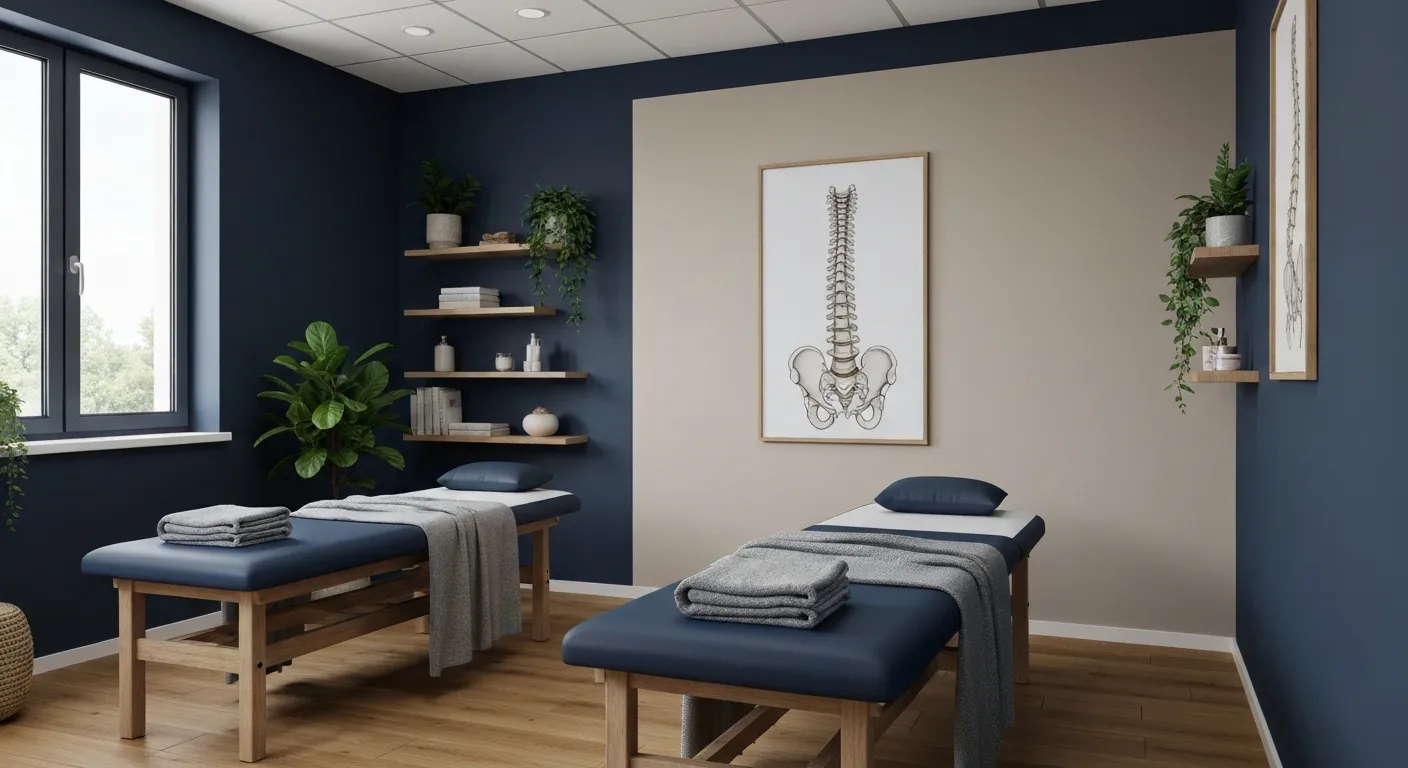Utilizing Physiotherapy to Enhance Chiropractic Treatment Outcomes
October 28, 2025
6 min

Integrating Two Disciplines for Superior Healing
Chiropractic care and physiotherapy independently offer significant benefits for musculoskeletal health, but when combined, their synergy enhances treatment effectiveness, accelerates recovery, and supports long-term wellness. This article examines how physiotherapy complements chiropractic treatment, creating a holistic, personalized approach that addresses both structural and functional aspects of the body to achieve optimal outcomes.
The Complementary Roles of Chiropractic Care and Physiotherapy

What are the key components of chiropractic care and physiotherapy, and how do they complement each other?
Chiropractic care centers on spinal adjustments aimed at correcting segmental dysfunctions, commonly known as subluxations. These adjustments improve spinal mobility, realign joints, and reduce nerve irritation, which enhances overall nervous system function. This approach quickly alleviates pain caused by misalignments and restores proper biomechanics.
Physiotherapy includes therapeutic exercises, manual therapies, and modalities like heat, ice, and electrostimulation. Its goals are to reduce pain, increase strength, improve flexibility, and retrain movement patterns, helping patients regain and maintain functional mobility.
How do chiropractic adjustments and physiotherapy exercises address musculoskeletal issues?
Chiropractic adjustments target the structural alignment of the spine and joints, addressing issues that cause nerve interference and joint restrictions. By restoring normal joint function, chiropractic care creates a foundation for mobility and pain relief.
Physiotherapy builds upon this foundation by focusing on functional recovery. Exercises strengthen muscles that support and stabilize joints, improve flexibility, and retrain the neuromuscular system to prevent future injury. Physical therapists also use manual therapy to relax tight muscles and improve circulation.
What are the benefits of an integrated treatment approach?
Combining chiropractic care and physiotherapy offers a synergistic effect that accelerates healing and enhances long-term outcomes. This integrative approach provides:
- Faster pain relief by addressing both structural spinal issues and muscular imbalances
- Improved joint mobility coupled with increased muscle strength and endurance
- Enhanced posture and functional movement
- Reduced risk of recurrent injuries due to better joint alignment and neuromuscular control
Personalized, holistic treatment plans ensure that each patient's unique condition and needs are optimally managed, significantly improving recovery speed and overall physical well-being.
Enhanced Treatment Outcomes through an Integrated Approach

How does integrating physiotherapy with chiropractic care enhance patient outcomes?
Integrating physiotherapy with chiropractic care delivers superior treatment benefits by comprehensively addressing both structural and functional body needs. Chiropractic spinal adjustments focus on realigning the spine and joints, mitigating nerve compression and restoring proper biomechanics. This provides immediate pain relief and improves joint mobility.
Physiotherapy complements these benefits by muscle strengthening and flexibility, using therapeutic exercises and flexibility training to enhance muscle endurance and improve movement patterns, which are essential for sustaining mobility gains and preventing further injury.
The combined approach leads to faster healing through combined care, as spinal alignment creates an optimal environment for physiotherapy exercises to be more effective. Patients experience quicker pain relief methods, greater range of motion, and enhanced muscle strength and endurance. Additionally, this integration promotes long-term prevention of re-injury by retraining proper neuromuscular function and educating patients on correct movement techniques.
Personalized, holistic treatment plans tailored to individual conditions ensure that both therapies work synergistically to maximize healing and functional restoration. Overall, this partnership between chiropractic care and physiotherapy offers a natural, drug-free path toward quicker, more complete recovery and sustained well-being (combining chiropractic care and physiotherapy).
Personalized, Evidence-Based Treatment Plans for Optimal Recovery
Why is a personalized, evidence-based approach important when combining physiotherapy and chiropractic care?
A personalized, evidence-based approach is vital because it ensures that each patient receives care tailored to their unique condition, history, and lifestyle. This customization maximizes treatment effectiveness and enhances safety by addressing specific structural and functional problems.
Both chiropractic care and physiotherapy utilize detailed assessments to thoroughly evaluate the patient's needs. Chiropractors focus on spinal alignment and nervous system health, while physiotherapists assess muscle strength, flexibility, and movement patterns. Combining these evaluations allows clinicians to design integrative treatment plans that target the root causes of pain and dysfunction.
Evidence-based practice means relying on the latest and most reliable scientific research alongside clinical expertise. This approach helps practitioners choose therapies proven to be effective, such as spinal adjustments supported by multiple randomized controlled trials and physiotherapy exercises that improve mobility and prevent injury.
Patient-centered care is another essential element. Treatment plans are developed with active input from patients, considering their preferences and goals. This collaboration promotes better adherence, satisfaction, and overall recovery.
In summary, integrating personalized assessments and evidence-based methods from both chiropractic and physiotherapy delivers the most comprehensive care. This strategy optimizes healing, reduces pain quickly, and supports long-term wellness through preventative education and adaptive therapies.
Managing Chronic Spinal Pain: Long-Term Strategies and Maintenance

How do chiropractic and physiotherapy treatments contribute to managing chronic spinal pain over the long term?
Managing chronic spinal pain effectively requires a comprehensive and sustained approach. Chiropractic care for chronic pain plays a vital role by restoring proper spinal alignment and reducing nerve irritation, which helps alleviate pain and improve nervous system function. Physiotherapy complements this by strengthening the muscles supporting the spine, enhancing flexibility, and retraining movement patterns to promote functional recovery.
Role of visit frequency and individualized maintenance plans
Evidence shows that patients who attend chiropractic treatments more than once weekly tend to experience better improvements in pain and function. This higher visit frequency allows more consistent care that supports ongoing symptom relief. However, once patients reach their Maximum Therapeutic Improvement (MTI), continued visits typically shift focus from further improvement to maintenance of function and quality of life.
Individualized maintenance plans are crucial. Tailored programs address each patient’s unique pain levels, functional status, and lifestyle factors to sustain gains and prevent re-injury. Long-term strategies emphasize balancing treatment frequency with patient goals, recognizing that chronic pain management often stabilizes rather than fully resolves symptoms (Chronic spinal pain management).
Enhancing quality of life through sustained care
Long-term chiropractic and physiotherapy care helps many patients manage chronic spinal pain by maintaining spinal alignment, strengthening muscles, and educating on movement and posture. This integrative, personalized approach not only reduces pain but also enhances mobility, endurance, and overall well-being, allowing individuals to enjoy better quality of life despite chronic conditions. Patients often report satisfaction with this holistic care model that prioritizes function and pain management over cure alone.
Innovations and Case Evidence Supporting Integrated Care
What evidence and innovations support the integration of physiotherapy with chiropractic care?
Innovative physiotherapy techniques like dry needling and proprioceptive neuromuscular facilitation have been shown to improve soft tissue healing, flexibility, and muscle elasticity. Additionally, virtual reality (VR) technologies support neuroplasticity, enhancing rehabilitation outcomes. These advances, combined with chiropractic care's chiropractic spinal adjustments, create a comprehensive and effective approach to managing musculoskeletal conditions.
Case studies highlight the success of such integrative treatment strategies. Notably, patients with complex issues, such as peroneal nerve injury causing foot drop, have demonstrated full recovery after 8 weeks of combined chiropractic and physical therapy interventions, including manual therapies, therapeutic exercises, and neuromuscular re-education.
Research also emphasizes that integrated care can be cost-effective and promotes high patient satisfaction. Studies indicate that combining both treatments accelerates recovery, reduces pain, and lowers the likelihood of future injuries. This approach supports maintaining optimal functional health by teaching patients proper movement and preventing recurrence.
Overall, integrating chiropractic and physiotherapy offers a personalized holistic treatment approach, noninvasive, and holistic treatment path that not only addresses immediate problems but also builds long-term strength, stability, and well-being.
A Holistic Path to Enhanced Healing
The integration of physiotherapy with chiropractic care represents a powerful, evidence-based strategy to enhance treatment outcomes for patients with musculoskeletal conditions. By addressing both structural alignment and functional muscle support, this multidisciplinary approach accelerates recovery, reduces pain, improves mobility, and helps prevent future injury. Personalized, patient-centered care plans tailored to individual needs, supported by ongoing research and innovative therapies, ensure long-term benefits and improved quality of life. For those seeking comprehensive musculoskeletal health, combining physiotherapy and chiropractic treatments offers a proven pathway to lasting wellness.
Recent articles

Long-Term Pain Relief Through Targeted Corrective Exercises

10 Benefits of Integrating Physiotherapy with Chiropractic Treatments

Corrective Exercises That Help Prevent Recurring Pain

8 Corrective Exercises Proven for Lasting Pain Relief

Lifestyle Habits for Maintaining a Healthy Spine

What You Will Experience at Your Initial Chiropractic Visit

What Happens at Your First Visit to a Chiropractor?

Focusing on Root Cause Analysis for Effective Pain Relief

Tips for Lifestyle Changes to Support Spinal Health

Holistic Treatment Plans: Alternatives to Surgery for Chronic Pain

Enhance Wellness Through Personalized Nutritional Counseling

Non-Invasive Pain Relief: Exploring Holistic Treatment Alternatives

Sciatica Relief Through Targeted Spinal Decompression

Integrating Physiotherapy with Chiropractic Treatments for Better Results

Testimonials That Demonstrate the Benefits of Chiropractic Care

The Power of Corrective Exercises in Pain Management

A Step-by-Step Guide to Your Initial Chiropractic Consultation

9 Nutritional Tips to Enhance Your Chiropractic Wellness Journey

Patient Experiences: How Chiropractic Care Changed Their Lives

Lifestyle Recommendations to Keep Your Spine in Top Shape

Effective Corrective Exercises for Long-Term Pain Relief

Back Pain Benefits: What Chiropractic Care Can Do for You

Spinal Decompression Techniques for Effective Sciatica Relief

Top Nutritional Counseling Tips for Enhanced Wellness

6 Lifestyle Habits That Boost Spine Health Daily

Discover Holistic and Non-Surgical Pain Relief Solutions

Exploring Holistic and Non-Surgical Treatment Options for Pain

The Role of Physiotherapy in Enhancing Chiropractic Care Outcomes

Complementing Chiropractic Care with Physiotherapy: What You Need to Know

What to Expect During Your First Chiropractic Visit

Simple Lifestyle Adjustments to Maintain a Healthy Spine

Personalized Nutritional Counseling for Improved Health Outcomes

Exploring Non-Surgical Treatments for Spine-Related Conditions

An Introduction to Spinal Decompression for Sciatica Patients

Transformative Success Stories: Patient Experiences with Chiropractic Treatments

Why Chiropractic Care Is Essential for Back Pain Relief

Addressing Underlying Causes Versus Symptom Management in Pain Care

The Role of Nutrition in Enhancing Chiropractic Treatment Effectiveness

Sciatica Treatment Options: Is Spinal Decompression Right for You?

Lifestyle Tips to Maintain a Healthy Spine and Prevent Back Issues

The Synergy Between Physiotherapy and Chiropractic Treatments

What Happens During Your Initial Chiropractic Consultation

Effective Corrective Exercises for Sustainable Pain Management

Taking a Root Cause Approach to Chronic Pain Management

Holistic Pain Management Techniques Without Surgery

How Patient Success Stories Validate Chiropractic Care Benefits

Spinal Decompression: Innovative Treatment for Sciatic Nerve Pain

Spinal Decompression Therapy: A Non-Invasive Approach to Sciatica Relief

Exploring Holistic Approaches Beyond Surgery for Pain Relief

Practical Lifestyle Advice to Support a Healthy Spine Every Day

Corrective Exercise Routines Designed for Long-Term Pain Prevention

Real Patient Stories: Overcoming Chronic Pain with Chiropractic Care

Lifestyle Changes That Promote a Healthy Spine and Prevent Injury

How Addressing the Root Cause of Pain Leads to Lasting Relief

Non-Surgical Holistic Therapies to Manage Chronic Pain Effectively

Nutritional Counseling's Impact on Physical Health and Healing

Benefits of Regular Chiropractic Care for a Stronger Back

Your First Chiropractic Visit: What to Expect and How to Prepare

Patient Experiences: How Chiropractic Care Transformed Their Lives

Exploring Holistic, Non-Surgical Options for Pain Management

Combining Physiotherapy with Chiropractic Treatments for Enhanced Recovery

Holistic Treatments That Offer Alternatives to Surgery for Pain Relief

Corrective Exercise Strategies for Long-Term Spine Health

How Physiotherapy Complements Chiropractic Adjustments for Better Outcomes

First-Time Chiropractic Visitors: What You Should Know

Understanding the Importance of Treating Pain at Its Source

Adopting Lifestyle Changes to Support Your Spine's Wellness

Utilizing Physiotherapy to Enhance Chiropractic Treatment Outcomes

The Key Advantages of Chiropractic Care for Back Pain Sufferers

Why Focusing on Root Causes Improves Pain Treatment Success

Corrective Exercises That Promote Lasting Pain Relief and Mobility

Sciatica Relief Through Targeted Spinal Decompression Techniques

Preparing for Your First Chiropractic Appointment with Confidence

Healthy Lifestyle Habits for Maintaining Spinal Alignment

Success Stories Highlighting Chiropractic's Role in Pain Recovery

Top Benefits of Chiropractic Care for Chronic Back Pain

Nutrition Tips to Boost Your Overall Wellness and Recovery

How Chiropractic Care Alleviates Back Pain Naturally

How Nutritional Counseling Supports Overall Wellness and Spine Health

Step-by-Step Guide to Your First Visit with a Chiropractor

Using Nutrition to Support Chiropractic and Overall Wellness

Integrating Physiotherapy in Your Chiropractic Healing Journey

How Physiotherapy Complements Chiropractic Adjustments for Faster Healing

Lifestyle Tips for Maintaining a Healthy Spine and Preventing Back Pain

Heartwarming Patient Testimonials Highlighting Chiropractic Success

How Proper Nutrition Supports Chiropractic and Physiotherapy Treatments

Combining Physiotherapy and Chiropractic Treatments for Optimal Recovery

Why Chiropractic Treatments Are Effective for Managing Back Pain

Choosing a Chiropractor: Tips for Finding a Trusted Provider

Integrating Physiotherapy and Chiropractic: Benefits and What to Expect

How Tailored Corrective Exercises Can Aid in Pain Management

Chiropractic Care: A Proven Solution for Alleviating Back Pain

What to Expect at Your First Chiropractic Visit: A Comprehensive Guide

The Importance of Root Cause Analysis in Effective Pain Management

The Role of Corrective Exercises in Sustaining Pain-Free Living

Combining Chiropractic and Physiotherapy for Comprehensive Pain Relief

How Addressing Underlying Causes Improves Pain Treatment Effectiveness

Maintaining Spinal Health Through Lifestyle Changes and Preventive Care

Understanding the Benefits of Chiropractic Adjustments for Back Pain Sufferers

